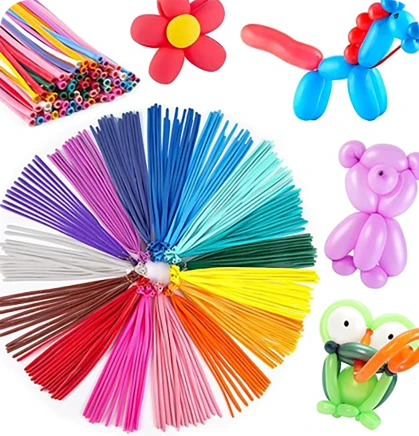Durable Standard Balloons for Parties & Events | Vibrant Colors
Introduction: Redefining Industrial Flexibility with Standard Balloon
In the demanding landscape of modern industrial operations, where precision, adaptability, and reliability are paramount, the evolution of flexible containment and sealing technologies has been transformative, ushering in an era where innovative solutions are essential for efficiency and safety; among these advancements, the Standard Balloon stands out as a critical component, moving beyond its rudimentary origins to become a highly engineered industrial device indispensable across a multitude of sectors. Historically, industrial 'balloons' were simple inflatable bladders, often used for basic sealing or temporary blockage; however, contemporary Standard Balloon products are complex systems, meticulously designed and manufactured from advanced polymer composites and reinforced elastomers, capable of withstanding extreme pressures, temperatures, and corrosive environments. This technological leap has positioned them as preferred solutions for applications ranging from pipeline isolation in petrochemical facilities to precision lifting in construction, and from environmental spill containment to temporary structural support in civil engineering projects. Their inherent flexibility allows them to conform to irregular shapes and spaces, providing a sealing or lifting mechanism where rigid alternatives are impractical or impossible, thereby reducing downtime, enhancing safety protocols, and optimizing operational workflows. The strategic application of a Standard Balloon in these high-stakes environments underscores its importance, not merely as a piece of equipment but as a sophisticated tool that directly contributes to operational continuity, risk mitigation, and cost-effectiveness. The industries benefiting from these advanced flexible solutions are diverse, including oil and gas, municipal water and wastewater management, mining, aerospace, and general manufacturing, each finding unique advantages in the adaptability and robust performance offered by these specialized inflatables. Their design focuses on rapid deployment, minimal footprint, and exceptional durability, making them an economically viable and technically superior choice for a myriad of B2B applications requiring temporary blockage, support, or sealed containment, thereby redefining the very essence of industrial flexibility and efficiency in the 21st century. This comprehensive exploration delves into the intricate engineering, diverse applications, and inherent advantages that cement the Standard Balloon's role as an essential asset in modern industrial processes, emphasizing its technical superiority and the strategic value it brings to complex operational challenges.
Engineering Excellence: The Meticulous Manufacturing Process of Standard Balloons
The production of a high-performance Standard Balloon is a sophisticated interplay of advanced material science, precision engineering, and rigorous quality control, ensuring each unit meets the stringent demands of industrial applications. The process begins with meticulous material selection, typically involving specialized elastomers such as natural rubber, neoprene, EPDM (ethylene propylene diene monomer), or nitrile rubber, often reinforced with high-tensile fabrics like nylon or Kevlar for enhanced strength and puncture resistance. These materials are chosen based on the intended application, considering factors like chemical compatibility, temperature range, abrasion resistance, and flexibility; for instance, applications in corrosive chemical environments necessitate materials with superior chemical resistance, while high-pressure applications demand exceptional tensile strength and tear resistance. Following material selection, the manufacturing sequence progresses through several critical stages: first, compounding, where raw polymers are mixed with various additives—such as vulcanizing agents, accelerators, antioxidants, and fillers—to achieve the desired physical and chemical properties, a process that determines the ultimate durability, elasticity, and lifespan of the final product. Next, the compounded material undergoes calendering or extrusion, forming continuous sheets of uniform thickness, which are then precisely cut into patterns using advanced CNC cutting machines, ensuring dimensional accuracy and minimizing material waste. The shaping and bonding of these material patterns constitute the core of the manufacturing process; this often involves precision molding or hot vulcanization, where the material is shaped under high pressure and temperature to form a seamless, robust structure, providing superior strength and integrity compared to simple adhesive bonding. For specific designs, such as those with complex geometries or requiring specialized attachments, techniques like radio-frequency (RF) welding or thermal bonding are employed to create strong, hermetic seams, crucial for maintaining internal pressure without leakage. After the primary shaping and bonding, a multi-stage curing or vulcanization process permanently sets the material's properties, rendering it highly resistant to deformation, environmental degradation, and fatigue. Throughout this entire manufacturing cycle, stringent quality control measures are implemented at every stage: this includes material inspection upon arrival, in-process checks for dimensional accuracy and bond integrity, and post-cure testing for material hardness, tensile strength, elongation at break, and burst pressure. Adherence to international standards such as ISO 9001 for quality management systems and specific ASTM or ANSI standards for material properties and testing protocols is paramount, ensuring that each Standard Balloon not only meets but often exceeds industry benchmarks for safety and performance. The typical lifespan of a well-maintained Standard Balloon can range from 5 to 15 years, depending on usage intensity and environmental conditions, a testament to its robust construction. This meticulous manufacturing ensures that the product is fit for critical industries such as petrochemicals, where pipeline integrity is vital; metallurgy, for specialized material handling; and municipal water and wastewater management, for effective flow isolation, demonstrating its inherent advantages in demanding operational environments.

Unpacking the Performance: Key Technical Parameters of the Standard Balloon
Understanding the comprehensive technical parameters of a Standard Balloon is crucial for engineers and procurement specialists to select the optimal solution for specific industrial challenges, as these specifications dictate the device’s suitability, safety, and long-term performance in demanding environments. Key parameters begin with Burst Pressure, which is the maximum internal pressure the balloon can withstand before catastrophic failure, a critical safety metric typically significantly higher than the operational working pressure to provide a substantial safety margin; this is rigorously tested and validated through destructive testing to ensure compliance with safety standards. Closely related is the Working Pressure, representing the maximum safe operating pressure under continuous or intermittent use, which is typically specified with a safety factor of 3:1 or 4:1 relative to the burst pressure, ensuring reliable performance without material fatigue or premature failure. Inflation Volume specifies the maximum internal volume the balloon can achieve when fully inflated, directly impacting its effective size and sealing or lifting capacity, while its range of Operating Temperatures defines the ambient and fluid temperatures the balloon can endure without material degradation, encompassing both high-heat industrial processes and cryogenic applications, a critical factor for chemical and process industries. Chemical Compatibility is another non-negotiable parameter, detailing the specific chemical substances (acids, alkalis, hydrocarbons, solvents) the balloon's material can safely come into contact with without compromising its structural integrity or performance, ensuring material resistance to corrosion and dissolution, which is vital in industries like petrochemicals and wastewater treatment. The Material Elasticity and Tensile Strength define the balloon’s ability to deform under stress and return to its original shape, as well as its resistance to stretching and tearing, respectively, directly influencing its durability and adaptability to irregular surfaces. Furthermore, Fatigue Cycles measure the number of inflation/deflation cycles a balloon can endure before showing signs of material fatigue, indicating its expected operational lifespan under dynamic conditions, a vital metric for applications requiring frequent use. Lastly, the Diameter Range or Size Range specifies the minimum and maximum dimensions of the pipe or opening the Standard Balloon can effectively seal or operate within, illustrating its versatility across various pipe sizes or spatial constraints. Each of these parameters is meticulously engineered and tested, providing a comprehensive performance profile that allows end-users to precisely match the Standard Balloon to their unique operational requirements, ensuring not only efficiency but also the highest levels of safety and longevity in their industrial applications. This data, often presented transparently by reputable manufacturers, enables informed decision-making for critical infrastructure projects and routine maintenance, highlighting the sophisticated engineering behind what appears to be a simple inflatable device.
Versatility in Action: Diverse Application Scenarios for Standard Balloons
The unparalleled adaptability of the Standard Balloon makes it an invaluable asset across an expansive array of industrial sectors, providing innovative solutions for complex challenges where traditional methods fall short; its inherent flexibility and robust design enable it to perform critical functions such as pipeline isolation, precision lifting, environmental containment, and leak testing with exceptional efficiency and safety. In the petrochemical and oil & gas industries, Standard Balloons are indispensable for pipeline blocking, allowing for safe and isolated sections of pipelines during maintenance, repair, or inspection. This prevents dangerous fluid or gas flow, significantly enhancing worker safety and minimizing environmental risks. For instance, during a planned shutdown, a Standard Balloon can be rapidly deployed to isolate a specific segment of an oil pipeline, allowing technicians to work on downstream sections without needing to drain the entire system, leading to substantial energy savings by preventing the loss of valuable hydrocarbons and reducing the need for extensive purging. Their corrosion resistance, particularly when fabricated from specialized elastomers like Nitrile or Viton, ensures longevity even in the presence of harsh chemicals and hydrocarbons, a distinct advantage over rigid stoppers that might degrade or fail. In municipal water and wastewater management, these balloons are crucial for flow diversion and blockage in sewer systems, water mains, and storm drains. They enable repair crews to work in dry environments, prevent contamination, and manage flood risks, proving their immense value in maintaining urban infrastructure. Their ability to conform to irregular pipe shapes ensures a watertight seal, even in aged or damaged pipes, preventing costly leaks and environmental spills. For construction and civil engineering, Standard Balloons serve as versatile lifting and leveling tools, capable of raising heavy structures, supporting beams, or aligning precast concrete elements with precision. Their pneumatic operation allows for controlled, gradual lifting, reducing the risk of structural damage and enhancing safety on site. This method is often more cost-effective and less intrusive than heavy machinery, especially in confined or difficult-to-access areas. Furthermore, in environmental protection and hazardous material response, specialized Standard Balloons are used for spill containment and emergency sealing of leaking drums or damaged vessels, offering rapid deployment to mitigate ecological impact and protect personnel. Their ability to quickly create a temporary barrier or seal a breach can be critical in preventing widespread contamination, making them a cornerstone of modern rapid response kits. The material composition often provides excellent chemical resistance, ensuring effectiveness against a wide range of hazardous substances. Beyond these major applications, the Standard Balloon also finds utility in mining for ventilation control, aerospace for precision component testing, and general manufacturing for custom jigging or pressure testing of various products. In each of these diverse scenarios, the Standard Balloon offers unique advantages, including rapid deployment, minimal footprint, non-damaging contact with surfaces, and high strength-to-weight ratios, contributing significantly to operational efficiency, enhanced safety, and substantial long-term cost savings by providing flexible, reliable, and often more energy-efficient alternatives to traditional industrial solutions. The intrinsic value of the Standard Balloon is its capacity to adapt to dynamic conditions, ensuring optimal performance across a spectrum of demanding B2B operational contexts.
Competitive Edge: Advantages and Manufacturer Insights in the Standard Balloon Market
In a highly competitive industrial market, the true value proposition of a Standard Balloon extends far beyond its basic function, resting firmly on its inherent technical advantages and the unwavering commitment of its manufacturers to engineering excellence, quality, and innovation, distinguishing premium products from generic alternatives. A primary competitive advantage lies in superior material science and advanced manufacturing precision; leading manufacturers invest heavily in R&D to develop proprietary rubber compounds and reinforced polymer fabrics that offer unmatched resistance to abrasion, chemicals, extreme temperatures, and UV radiation, significantly extending the lifespan and reliability of the Standard Balloon even in the harshest environments. For example, while a generic balloon might use standard rubber, a high-quality Standard Balloon could incorporate specialized synthetic elastomers like Chloroprene (Neoprene) for oil resistance or EPDM for ozone and weather resistance, reinforced with high-strength aramid fibers, ensuring it maintains its integrity and sealing capabilities under prolonged stress and exposure. Furthermore, the use of sophisticated manufacturing techniques, such as seamless molding, robotic welding, or advanced vulcanization processes, ensures uniformity in wall thickness, eliminates weak points, and guarantees consistent burst pressure ratings, which directly translates to enhanced safety and predictable performance. Another significant competitive edge is customizability and application-specific design, as many industrial operations have unique requirements that cannot be met by off-the-shelf products; reputable manufacturers offer bespoke Standard Balloon solutions, tailored to specific diameters, lengths, pressure ratings, chemical exposures, and even incorporating integrated features like bypass ports, inflation/deflation valves, or pressure monitoring sensors, thereby providing a perfect fit for complex or unconventional applications. This level of customization ensures optimal efficiency and safety, making the solution an integral part of the client's operational infrastructure rather than a mere accessory. Long-term reliability and low total cost of ownership (TCO) also serve as crucial differentiators. While the initial investment in a premium Standard Balloon might be higher than for a lower-quality generic product, its extended lifespan, reduced maintenance requirements, superior performance, and minimized risk of operational failures or safety incidents lead to significantly lower TCO over its operational life. This reliability is backed by stringent quality control protocols, often including 100% pressure testing and comprehensive material certifications, providing peace of mind to B2B purchasers. Finally, comprehensive technical support and service longevity further set leading manufacturers apart; this includes pre-sales consultation to identify the correct product, on-site training for proper deployment and maintenance, readily available spare parts, and responsive post-sales support, all contributing to maximum uptime and ensuring that clients can fully leverage the capabilities of their Standard Balloon products throughout their entire lifecycle. The competitive landscape for Standard Balloon products therefore emphasizes not just the product itself, but the entire ecosystem of engineering, quality assurance, and customer support that ensures its enduring value and performance in critical industrial applications, making the choice of manufacturer as important as the product's specifications.
Tailored Solutions: Customization and Bespoke Standard Balloon Designs
Recognizing that the unique operational challenges faced by B2B clients often necessitate solutions beyond off-the-shelf products, the ability to provide highly customized Standard Balloon designs is a hallmark of a truly responsive and expert manufacturer, ensuring that specific, often complex, industrial requirements are met with precision and efficacy. Customization for a Standard Balloon transcends mere size adjustments; it encompasses a sophisticated array of design modifications concerning material composites, specific shapes, pressure ratings, and integrated functionalities, all meticulously engineered to optimize performance for a given application. The process typically begins with an in-depth consultation phase, where our team of experienced engineers collaborates closely with the client to thoroughly understand the exact operational environment, including the type of fluid or gas to be contained, the pipe or opening geometry, required pressure and temperature ranges, deployment constraints, and specific safety protocols. This detailed discovery ensures that every critical parameter is accounted for from the outset. Based on this comprehensive understanding, material composites are meticulously selected or even developed: for instance, if the application involves aggressive acids, specialized fluoroelastomers like Viton might be chosen, while high-abrasion environments could call for specific blends of natural rubber reinforced with Kevlar; the fiber reinforcement structure can also be optimized for directional strength or enhanced tear resistance. The shape and size of the Standard Balloon can be precisely tailored, moving beyond cylindrical designs to create conical, spherical, or even highly irregular geometries that conform perfectly to non-standard openings, tunnels, or complex internal structures, ensuring a complete and reliable seal. Furthermore, pressure ratings can be custom-engineered to withstand specific burst and working pressures, providing an extra layer of safety and confidence for ultra-high pressure applications. Integrated features represent another crucial dimension of customization: this includes incorporating bespoke inflation/deflation valves, often with quick-connect fittings for rapid deployment; embedding pressure sensors or gauges for real-time monitoring of internal pressure during operation; adding bypass ports for fluid or gas transfer around the sealed area; or integrating specialized attachment points for ropes, cables, or handling equipment, significantly enhancing usability and operational versatility. Surface treatments or coatings can also be applied for enhanced chemical resistance, improved slip, or anti-fouling properties, depending on the fluid and environment. Throughout the design process, iterative design and validation phases are critical, utilizing advanced CAD modeling and finite element analysis (FEA) to simulate performance under anticipated stresses, ensuring the theoretical design meets practical demands before physical prototyping. This rigorous approach minimizes risks and optimizes the design for manufacturability and performance. By offering such extensive customization capabilities, manufacturers ensure that each Standard Balloon is not just a product, but a precision-engineered solution, perfectly aligned with the client's unique operational needs, thereby delivering superior efficacy, enhanced safety, and maximizing return on investment in the most challenging industrial contexts.
Proven Impact: Real-World Case Studies and Customer Success with Standard Balloons
The true measure of any industrial product's efficacy lies in its proven performance in real-world applications, and the Standard Balloon has consistently demonstrated its critical value through numerous successful deployments across various challenging sectors, delivering tangible benefits and garnering positive feedback from satisfied clients. These application cases underscore the versatility, reliability, and innovative problem-solving capabilities inherent in a high-quality Standard Balloon.
Case Study A: Emergency Pipeline Sealing in a Major Refinery
A leading petrochemical refinery faced an unexpected challenge when a critical section of a crude oil pipeline developed a minor leak during routine operation, necessitating immediate isolation for repair to prevent significant environmental contamination and production loss. Traditional methods would have involved a full system shutdown, draining hundreds of meters of pipeline, and days of lost production. Our engineering team rapidly assessed the situation and recommended the deployment of a specialized Standard Balloon designed for high-pressure crude oil environments. The Standard Balloon was custom-sized to fit the 24-inch pipeline and rated for the specific hydrocarbon content and operating pressure. It was rapidly deployed upstream of the leak site via an existing access point. Within hours, the balloon was inflated to its specified working pressure, achieving a complete, hermetic seal that allowed technicians to safely repair the compromised section without fully de-pressurizing or draining the extensive pipeline network. This swift and precise isolation averted a potential environmental disaster, saved an estimated 72 hours of production downtime, translating to millions in recovered revenue, and minimized the logistical complexities associated with a full shutdown. The refinery praised the Standard Balloon for its rapid deployment, exceptional reliability, and the significant cost savings achieved, highlighting its role as a vital tool in their emergency response and maintenance protocols.
Case Study B: Precision Lifting and Alignment in Bridge Construction
A civil engineering firm constructing a new pedestrian bridge encountered an unforeseen challenge during the final alignment of a massive concrete arch section; slight ground shifts had resulted in a several-millimeter misalignment, preventing the seamless connection of two large structural components. Conventional hydraulic jacks proved too rigid and lacked the fine adjustment capabilities required for such delicate alignment, risking damage to the precast elements. Our solution involved deploying multiple, interconnected Standard Balloons beneath the misaligned concrete section. These industrial inflatables, constructed from robust, abrasion-resistant polymer composites, were strategically placed to distribute the lifting force evenly. Using a synchronized pneumatic control system, the balloons were incrementally inflated, allowing for micro-adjustments in height and lateral position with exceptional precision. This controlled, gentle lifting technique enabled the construction crew to slowly raise and precisely maneuver the concrete arch into perfect alignment, facilitating the seamless connection within just 8 hours. The client reported that the Standard Balloon system was not only more precise than traditional methods but also significantly safer, as it minimized stress concentrations on the concrete elements and reduced the risk of sudden movements. The project manager lauded the efficiency and accuracy provided by the Standard Balloon, stating, "The precise control offered by these industrial balloons saved us days of costly rework and ensured the structural integrity of the bridge section. It's an indispensable tool for complex alignments." This application demonstrated the Standard Balloon's capacity for controlled force application and its versatility in intricate structural engineering tasks.
These and countless other success stories underscore the practical advantages of the Standard Balloon across diverse industries. From enhancing safety and efficiency in critical infrastructure projects to providing innovative solutions for unforeseen operational challenges, the real-world impact of this versatile device reaffirms its position as a high-value, reliable, and indispensable tool in the modern B2B industrial landscape, consistently exceeding client expectations and proving its worth through quantifiable benefits and operational improvements.
Ensuring Confidence: Trust, Support, and FAQ for Your Standard Balloon Investment
At the core of any successful B2B partnership, particularly when dealing with critical industrial equipment like a Standard Balloon, lies an unwavering commitment to trust, transparent support, and comprehensive after-sales service, ensuring that clients not only receive a superior product but also gain a reliable partner for their long-term operational needs. Our dedication to fostering this trust is evident in every facet of our client engagement, from initial inquiry to post-delivery support and beyond, providing a seamless and confident experience.
Frequently Asked Questions (FAQ) about Standard Balloons:
Q1: What is the typical lifespan of a Standard Balloon, and how can I maximize it?
A1: The average lifespan of a well-maintained Standard Balloon ranges from 5 to 15 years, depending on the material, frequency of use, and environmental conditions. To maximize its lifespan, always adhere to the specified working pressure, avoid over-inflation, ensure proper cleaning and storage in a cool, dry place away from direct sunlight and harsh chemicals, and conduct regular visual inspections for any signs of wear or damage. Proper inflation and deflation procedures, as outlined in the user manual, are also crucial.
Q2: Can Standard Balloons be repaired if damaged?
A2: Minor punctures or surface abrasions on a Standard Balloon can often be professionally repaired using specialized patch kits and vulcanization techniques, restoring its integrity and extending its operational life. However, extensive damage, such as large tears, seam failures, or severe material degradation, typically necessitates replacement to ensure safety and optimal performance. We offer repair assessment services and can advise on the best course of action.
Q3: What inflation medium should I use for my Standard Balloon?
A3: The primary inflation medium for most Standard Balloon models is compressed air, which should be clean and dry to prevent internal contamination. For certain applications, especially where higher pressure or incompressible media are required, water can also be used as an inflation medium. Always refer to the product’s specific guidelines for recommended inflation media and pressure requirements.
Q4: How do I select the correct size and material for my application?
A4: Selecting the right Standard Balloon involves considering the exact internal diameter of the pipe or opening to be sealed, the maximum operating pressure, the temperature range of the environment and any contained fluids, and the chemical compatibility requirements. Our technical sales team and engineering experts are available for detailed consultations to help you specify the ideal balloon model and material composition for your unique operational needs, ensuring optimal performance and safety.
Q5: What are the safety precautions when using a Standard Balloon?
A5: Safety is paramount. Always operate the Standard Balloon within its specified working pressure limits, use calibrated pressure gauges, and never over-inflate. Ensure the work area is clear, and personnel are aware of the inflation process. Use appropriate personal protective equipment (PPE). Regularly inspect the balloon for damage before each use. Adherence to manufacturer guidelines and industry safety standards (e.g., OSHA, local regulations) is crucial to prevent accidents.
Beyond the FAQ, our commitment to trustworthiness extends to our transparent delivery cycles and global logistics capabilities. We understand that timely delivery is critical for industrial operations, which is why we offer clear, reliable lead times and leverage a robust global supply chain network to ensure your Standard Balloon arrives precisely when and where you need it, minimizing project delays. Our comprehensive warranty policies reflect our confidence in the quality and durability of our products, providing clear terms and conditions that protect your investment and ensure peace of mind. Furthermore, our responsive customer support and technical assistance teams are always available, providing expert guidance, troubleshooting, and post-sales service, from initial setup to long-term maintenance. We believe in building lasting relationships, offering ongoing support and expertise to ensure your Standard Balloon continues to perform optimally throughout its entire operational life, solidifying our reputation as a trusted partner in industrial solutions.
Conclusion: Pioneering the Future of Flexible Industrial Solutions
In conclusion, the modern Standard Balloon transcends its perceived simplicity to stand as a pinnacle of flexible engineering, an indispensable tool that continues to redefine efficiency, safety, and operational agility across a diverse range of B2B industrial sectors. From the meticulous selection of advanced polymer composites to precision manufacturing processes that ensure unparalleled durability and performance, every aspect of its design and production is geared towards meeting and exceeding the rigorous demands of complex environments. Its proven versatility in critical applications—ranging from isolating hazardous pipelines in petrochemical facilities to providing precise lifting and alignment in civil engineering projects, and from enabling efficient wastewater management to mitigating environmental risks—underscores its strategic value. The inherent advantages of a high-quality Standard Balloon, including rapid deployment, exceptional conformity to irregular shapes, superior chemical and temperature resistance, and a significantly lower total cost of ownership over its lifespan, position it as a technologically superior and economically viable alternative to traditional, often rigid, industrial solutions. As industries continue to evolve, facing new challenges that demand greater adaptability and innovative problem-solving, the role of the Standard Balloon is set to expand further. Its capacity for customization, backed by expert engineering and responsive customer support, ensures that it remains at the forefront of flexible containment and sealing technologies, continually adapting to bespoke client needs and driving operational excellence. Investing in a robust, expertly manufactured Standard Balloon is not merely a procurement decision; it is a strategic investment in enhanced safety, increased operational efficiency, and long-term reliability, solidifying its status as a critical enabler for the future of industrial flexibility.
References and Further Reading
- "Advanced Elastomers in High-Performance Industrial Inflatables: Innovations and Applications." Industrial Rubber Journal, Vol. 45, No. 2, 2023, pp. 87-95.
- "Enhancing Pipeline Safety and Efficiency Through Advanced Isolation Technologies." Pipeline Technology Review, online forum discussion, January 2024.
- "Flexible Solutions for Municipal Infrastructure: The Role of Inflatable Pipe Plugs." Water & Wastewater International, Special Report, 2022, pp. 30-35.
-
The Multifaceted Allure of Matte BalloonsNewsAug.11,2025
-
Professional Insights into Pastel Balloon DecorationNewsAug.11,2025
-
Pearl Balloons An In-Depth Technical ExpositionNewsAug.11,2025
-
Metallic Balloons Transforming Event Design with Professional EleganceNewsAug.11,2025
-
Mastering Retro Balloon Decor Expert Design StrategiesNewsAug.11,2025
-
Boundless Creativity of Colorful Latex BalloonsNewsAug.11,2025
-
Valentine’s Day Balloon ExtravaganzaNewsJun.27,2025
Welcome friends and customers at home and abroad to cooperate sincerely and create brilliance together!
-
 Service Emailhu@festivalballoon.com
Service Emailhu@festivalballoon.com -
 Service Phone+86 18831270668
Service Phone+86 18831270668
 Consult now
Consult now





























